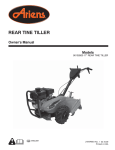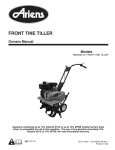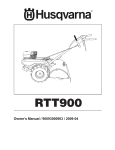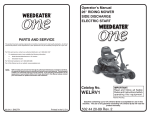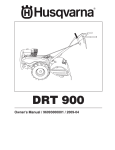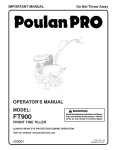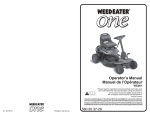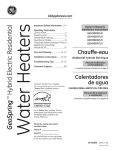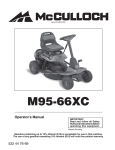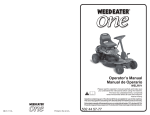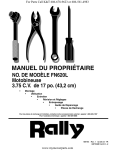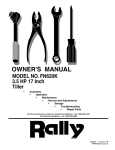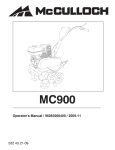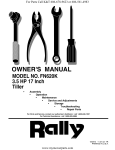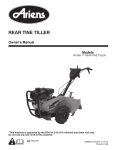Download Ariens 90203200 Owner`s manual
Transcript
FRONT TINE TILLER Owners Manual Models 902032 24" FRONT TINE TILLER ENGLISH 21547014 423442 Rev 1 02.10.09 Printed in USA SAFETY RULES Safe Operation Practices for Walk-Behind Powered Rotary Tillers TRAINING • • • • • Read the Owner’s Manual carefully. Be thoroughly familiar with the controls and the proper use of the equipment. Know how to stop the unit and disengage the controls quickly. Never allow children to operate the equipment. Never allow adults to operate the equipment without proper instruction. Keep the area of operation clear of all persons, particularly small children, and pets. • • • • • PREPARATION • • • • • • • • • • Thoroughly inspect the area where the equipment is to be used and remove all foreign objects. Disengage all clutches and shift into neutral before starting the engine (motor). Do not operate the equipment without wearing adequate outer garments. Wear footwear that will improve footing on slippery surfaces. Handle fuel with care; it is highly flammable. Use an approved fuel container. Never add fuel to a running engine or hot engine. Fill fuel tank outdoors with extreme care. Never fill fuel tank indoors. Replace gasoline cap securely and clean up spilled fuel before restarting. Use extension cords and receptacles as specified by the manufacturer for all units with electric drive motors or electric starting motors. Never attempt to make any adjustments while the engine (motor) is running (except where specifically recommended by manufacturer). MAINTENANCE AND STORAGE • • • • • • • • • • • • Keep machine, attachments, and accessories in safe working condition. Check shear pins, engine mounting bolts, and other bolts at frequent intervals for proper tightness to ensure the equipment is in safe working condition. Never store the machine with fuel in the fuel tank inside a building where ignition sources are present, such as hot water and space heaters, clothes dryers, and the like. Allow the engine to cool before storing in any enclosure. Always refer to the operator’s guide instructions for important details if the tiller is to be stored for an extended period. - IMPORTANT CAUTIONS, IMPORTANTS, AND NOTES ARE A MEANS OF ATTRACTING ATTENTION TO IMPORTANT OR CRITICAL INFORMATION IN THIS MANUAL. IMPORTANT: USED TO ALERT YOU THAT THERE IS A POSSIBILITY OF DAMAGING THIS EQUIPMENT. OPERATION • • Keep children and pets away. Do not overload the machine capacity by attempting to till too deep at too fast a rate. Never operate the machine at high speeds on slippery surfaces. Look behind and use care when backing. Never allow bystanders near the unit. Use only attachments and accessories approved by the manufacturer of the tiller. Never operate the tiller without good visibility or light. Be careful when tilling in hard ground. The tines may catch in the ground and propel the tiller forward. If this occurs, let go of the handlebars and do not restrain the machine. Do not put hands or feet near or under rotating parts. Exercise extreme caution when operating on or crossing gravel drives, walks, or roads. Stay alert for hidden hazards or traffic. Do not carry passengers. After striking a foreign object, stop the engine (motor), remove the wire from the spark plug, thoroughly inspect the tiller for any damage, and repair the damage before restarting and operating the tiller. Exercise caution to avoid slipping or falling. If the unit should start to vibrate abnormally, stop the engine (motor) and check immediately for the cause. Vibration is generally a warning of trouble. Stop the engine (motor) when leaving the operating position. Take all possible precautions when leaving the machine unattended. Disengage the tines, shift into neutral, and stop the engine. Before cleaning, repairing, or inspecting, shut off the engine and make certain all moving parts have stopped. Disconnect the spark plug wire, and keep the wire away from the plug to prevent accidental starting. Disconnect the cord on electric motors. Do not run the engine indoors; exhaust fumes are dangerous. Never operate the tiller without proper guards, plates, or other safety protective devices in place. NOTE: Gives essential information that will aid you to better understand, incorporate, or execute a particular set of instructions. Look for this symbol to point out important safety precautions. It means CAUTION!!! BECOME ALERT!!! YOUR SAFETY IS INVOLVED. CAUTION: Always disconnect spark plug wire and place wire where it cannot contact spark plug in order to prevent accidental starting when setting up, transporting, adjusting or making repairs. WARNING The engine exhaust from this product contains chemicals known to the State of California to cause cancer, birth defects, or other reproductive harm. 2 PRODUCT SPECIFICATIONS CUSTOMER RESPONSIBILITIES • • Read and observe the safety rules. Follow a regular schedule in maintaining, caring for and using your tiller. Follow instructions under “Maintenance” and “Storage” sections of this Manual. Gasoline Capacity: 3.6 Quarts (3.4L) Unleaded Regular Oil (API-SG-SL): (Capacity: 20 oz./0.6L) SAE 10w-30(Above 32°F/0°C) SAE 5w-30(Below 32°F/0°C) • Spark Plug: (Gap: .030"/0.76mm) NGK BR-5HS (Champion RL86C) IMPORTANT: THIS UNIT IS EQUIPPED WITH AN INTERNAL COMBUSTION ENGINE AND SHOULD NOT BE USED ON OR NEAR ANY UNIMPROVED FOREST-COVERED, BRUSHCOVERED OR GRASS COVERED LAND UNLESS THE ENGINE'S EXHAUST SYSTEM IS EQUIPPED WITH A SPARK ARRESTER MEETING APPLICABLE LOCAL LAWS (IF ANY). IF A SPARK ARRESTER IS USED, IT SHOULD BE MAINTAINED IN EFFECTIVE WORKING ORDER BY THE OPERATOR. IN THE STATE OF CALIFORNIA, A SPARK ARRESTER IS REQUIRED BY LAW (SECTION 4442 OF THE CALIFORNIA PUBLIC RESOURCES CODE). OTHER STATES MAY HAVE SIMILAR LAWS. FEDERAL LAWS APPLY ON FEDERAL LANDS. SEE YOUR AUTHORIZED SERVICE CENTER/DEPARTMENT FOR SPARK ARRESTER. CONGRATULATIONS on your purchase of a new tiller. It has been designed, engineered and manufactured to give you the best possible dependability and performance. Should you experience any problems you cannot easily remedy, please contact your nearest authorized service center. We have competent, well-trained technicians and the proper tools to service or repair this unit. Please read and retain this manual. The instructions will enable you to assemble and maintain your tiller properly. Always observe the “SAFETY RULES”. TABLE OF CONTENTS MAINTENANCE ..................................................... 10-12 SERVICE & ADJUSTMENTS ................................. 13-15 STORAGE .................................................................... 16 TROUBLESHOOTING ................................................. 17 PARTS..................................................................... 18-29 WARRANTY............................................................ 30-31 PARTS AND SERVICE ................................................ 32 SAFETY RULES ............................................................ 2 PRODUCT SPECIFICATIONS ....................................... 3 CUSTOMER RESPONSIBILITIES................................. 3 ASSEMBLY ................................................................. 4-5 OPERATION ............................................................... 6-9 MAINTENANCE SCHEDULE ...................................... 10 3 ASSEMBLY Your new tiller has been assembled at the factory with exception of those parts left unassembled for shipping purposes. To ensure safe and proper operation of your tiller all parts and hardware you assemble must be tightened securely. Use the correct tools as necessary ensure proper tightness. TOOLS REQUIRED FOR ASSEMBLY FRONT overhead_views_8 A socket wrench set will make assembly easier. Standard wrench sizes are listed. (1) Utility Knife (1) Screwdriver (2) 1/2" Wrenches LEFT RIGHT OPERATOR’S POSITION (See Fig. 1) When right or left hand is mentioned in this manual, it means when you are in the operating position (standing behind tiller handles). OPERATOR'S POSITION Fig. 1 CONTENTS OF HARDWARE PACK (2) Hex Bolts 5/16-18 x 1 (4) Hex Bolts 5/16-18 x 1-1/4 (4) Washers 3/8 x 7/8 x 14 (6) Lock Washers 5/16 4 (6) Hex Nuts 5/16-18 ASSEMBLY UNPACK CARTON & INSTALL HANDLE (See Fig. 2) INSTALL DEPTH STAKE ASSEMBLY (See Fig. 3) • • CAUTION: Be careful of exposed staples when handling or disposing of cartoning material. • IMPORTANT: WHEN UNPACKING AND AS SEMBLING TILLER, BE CAREFUL NOT TO STRETCH OR KINK CABLE(S). • • NUT LOCK WASHER HANDLE PANEL de pt sta ke _ A ( &4 HEX BOLTS, LOCK WASHERS, AND HEX NUTS STAKE SPRING Fig. 3 HANDLE HEIGHT HEX BOLT 5/16-18X1" • Handle height may be adjusted to better suit operator. (See “HANDLE HEIGHT” in the Service and Adjustments section of this manual.) TILLING WIDTH CABLE(S) • HANDLE PANEL BOLTS TILLER HANDLES DEPTH STAKE SUPPORT BOLT HEX BOLT 5/16-18X1-1/4" EL? AN ª0 4 TILLER HANDLE FLAT WASHER LE ND ENGINE BRACKET HALVES NUT “A” h_ DEPTH STAKE SUPPORT 1 • Cut cable ties securing handles. Slowly lift handle assembly up, route cable(s) as shown and align handle holes with handle panel hole and slot. Loosely assemble hardware as shown. the shorter (1" long) hex bolt is assembled in lower hole of handle. Repeat for opposite side. Tighten all hardware securely. Cut cable ties securing tiller to skid and remove tiller from skid. Remove screws securing depth stake to skid and discard the screws. 0205 • • • Loosen nut “A”. Insert stake support between engine bracket halves with stake spring down. Bolt stake support to engine brackets with bolts, lock washers and nuts. Tighten securely. Tighten nut “A”. Depth stake must move freely. If it does not, loosen support bolt. Tilling width may be adjusted to better handle your tilling conditions (See “TINE ARRANGEMENT” in the Service and Adjustments section of this manual.) TINE OPERATION • Fig. 2 5 Check tine operation before first use. (See “TINE OPERATION CHECK” in the Service and Adjustments section of this manual.) OPERATION KNOW YOUR TILLER READ THIS MANUAL AND SAFETY RULES BEFORE OPERATING YOUR TILLER. Compare the illustrations with your tiller to familiarize yourself with the location of various controls and adjustments. Save this manual for future reference. These symbols may appear on your Tiller or in literature supplied with the product. Learn and understand their meaning. FORWARD TINE CONTROL CHOKE CONTROL THROTTLE CONTROL FUEL VALVE ENGINE SWITCH DEPTH STAKE TINE SHIELD RECOIL STARTER TINES Fig. 4 MEETS ANSI SAFETY REQUIREMENTS Our tillers conform to the safety standards of the American National Standards Institute. CHOKE CONTROL - Used when starting a cold engine. DEPTH STAKE - Controls forward speed and the depth at which the tiller will dig. ENGINE ON/OFF SWITCH - The engine switch enables and disables the ignition system. FORWARD TINE CONTROL - Engages tines in forward direction. FUEL VALVE - The fuel valve opens and closes the passage between the fuel tank and the carburetor. RECOIL STARTER HANDLE - Used to start the engine. direction. THROTTLE CONTROL - Controls engine speed. 6 OPERATION The operation of any tiller can result in foreign objects thrown into the eyes, which can result in severe eye damage. Always wear safety glasses or eye shields before starting your tiller and while tilling. We recommend a wide vision safety mask for over spectacles or standard safety glasses. HOW TO USE YOUR TILLER TINE OPERATION (See Fig. 5) Know how to operate all controls before adding fuel and oil or attempting to start engine. TILLING • STOPPING (See Fig. 5) Squeeze tine control to handle. The speed and depth of tilling is regulated by the position of the depth stake and wheel height. The depth stake should always be below the wheels for digging. It serves as a brake to slow the tiller’s forward motion to enable the tines to penetrate the ground. Also, the more the depth stake is lowered into the ground the deeper the tines will dig. TINES 1. Release tine control to stop movement. ENGINE 2. Set the speed control lever at the low speed position and allow the engine to run at low speed for 1 or 2 minutes before stopping. 3. Turn the ENGINE SWITCH counterclockwise to the position “ O ” (OFF). 4. Close the fuel valve. 5. Pull the starter handle slowly and return the handle to its original position when resistance is felt. This operation is necessary to prevent outside moist air from intruding into the combustion chamber. NOTE: Never use choke to stop engine. DEPTH STAKE (See Fig. 6) Adjust depth stake by removing the hairpin clip and clevis pin. Change depth stake to desired position. Replace the clevis pin and hairpin clip. • For normal tilling, set depth stake at the second or third hole from the top. WHEELS (See Fig. 6) Adjust wheels by removing the hairpin clip and clevis pin. Change wheel position. Replace the hairpin clip and clevis pin. • For normal tilling, set wheels at the second or third hole from the top. IMPORTANT: TO STOP ENGINE IN AN EMERGENCY, TURN THE ENGINE SWITCH TO THE OFF POSITION. TINE CONTROL “OFF” (UP) POSITION de pt HAIRPIN CLIP AND CLEVIS PIN h_ sta ke _ 4 TINE CONTROL “ON” (DOWN) POSITION THROTTLE CONTROL ENGINE SWITCH FUEL VALVE DEPTH STAKE STAKE SPRING WHEEL ENGINE SWITCH Fig. 6 THROTTLE CONTROL RECOIL STARTER FUEL VALVE Fig. 5 7 OPERATION TO TRANSPORT ADD GASOLINE • CAUTION: Before lifting or transporting, allow tiller engine and muffler to cool. Disconnect spark plug wire. Drain gasoline from fuel tank. AROUND THE YARD • Tip depth stake forward until it is held by the stake spring. • Push tiller handles down, raising tines off the ground. • Push or pull tiller to desired location. Fill fuel tank to bottom of filler neck. Do not overfill. Use fresh, clean, regular unleaded gasoline with a minimum of 87 octane. (Use of leaded gasoline will increase carbon and lead oxide deposits and reduce valve life). Do not mix oil with gasoline. Purchase fuel in quantities that can be used within 30 days to assure fuel freshness. CAUTION: Fill to within 1/2 inch of top of fuel tank to prevent spills and to allow for fuel expansion. If gasoline is accidentally spilled, move machine away from area of spill. Avoid creating any source of ignition until gasoline vapors have disappeared. Wipe off any spilled oil or fuel. Do not store, spill or use gasoline near an open flame. AROUND TOWN • Disconnect spark plug wire. • Drain fuel tank. • Transport in upright position to prevent oil leakage. BEFORE STARTING ENGINE IMPORTANT: BE VERY CAREFUL NOT TO ALLOW DIRT TO ENTER THE ENGINE WHEN CHECKING OR ADDING OIL OR FUEL. USE CLEAN OIL AND FUEL AND STORE IN APPROVED, CLEAN, COVERED CONTAINERS. USE CLEAN FILL FUNNELS. IMPORTANT: WHEN OPERATING IN TEMPERATURES BELOW 32°F(0°C), USE FRESH, CLEAN WINTER GRADE GASOLINE TO HELP ENSURE GOOD COLD WEATHER STARTING. FILL ENGINE WITH OIL (See Fig. 7) 1. Remove hangtag from engine. 2. With engine level, remove engine oil filler plug. 3. Fill engine with oil to point of overflowing. For approximate capacity see “PRODUCT SPECIFICATIONS” on page 3 of this manual. All oil must meet A.P.I. Service Classification SG-SL. 4. Tilt tiller back on its wheels and then re-level. 5. With engine level, refill to point of overflowing if necessary. Replace oil filler plug. • For cold weather operation you should change oil for easier starting (See “OIL VISCOSITY CHART” in the Maintenance section of this manual). • To change engine oil, see the Maintenance section of this manual. CAUTION: Alcohol blended fuels (called gasohol or using ethanol or methanol) can attract moisture which leads to separation and formation of acids during storage. Acidic gas can damage the fuel system of an engine while in storage. To avoid engine problems, the fuel system should be emptied before storage of 30 days or longer. Drain the gas tank, start the engine and let it run until the fuel lines and carburetor are empty. Use fresh fuel next season. See Storage Instructions for additional information. Never use engine or carburetor cleaner products in the fuel tank or permanent damage may occur. TO START ENGINE (See Fig. 8) CAUTION: KEEP TINE CONTROL IN “OFF” POSITION WHEN STARTING ENGINE. 1. Open the fuel valve. 2. Turn the ENGINE SWITCH to the position “ I ” (ON). 3. Set the speed control lever 1/3 of the way towards the high speed position. 4. Close the choke lever. OIL FILLER PLUG OIL LEVEL NOTE: If the engine is cold or the ambient temperature is low, close the choke lever fully. NOTE: If the engine is warm or the ambient temperature is high, open the choke lever half-way, or keep it fully open. 5. Pull the starter handle slowly until resistance is felt. This is the “compression” point. Return the handle to its original position and pull swiftly. Do not pull out the rope all the way. After starting the engine, allow the starter handle to return to its original position while still holding the handle. MAXIMUM UPPER LEVEL MINIMUM UPPER LEVEL Fig. 7 8 OPERATION • 6. After starting the engine, gradually open choke by turning the choke lever and finally keep it fully opened. Do not fully open the choke lever immediately when the engine is cold or the ambient temperature is low, because the engine may stop. NOTE: If engine does not start, see troubleshooting points. • ENGINE SWITCH THROTTLE CONTROL SPARK PLUG • RECOIL STARTER CHOKE CONTROL Soil conditions are important for proper tilling. Tines will not readily penetrate dry, hard soil which may contribute to excessive bounce and difficult handling of your tiller. Hard soil should be moistened before tilling; however, extremely wet soil will “ball-up” or clump during tilling. Wait until the soil is less wet in order to achieve the best results. When tilling in the fall, remove vines and long grass to prevent them from wrapping around the tine shaft and slowing your tilling operation. You will find tilling much easier if you leave a row untilled between passes. Then go back between tilled rows. (See Fig. 9) There are two reasons for doing this. First, wide turns are much easier to negotiate than about-faces. Second, the tiller won’t be pulling itself, and you, toward the row next to it. Set depth stake and wheel height for shallow tilling when working extremely hard soil or sod. Then work across the first cuts at normal depth. FUEL VALVE Fig. 8 BREAKING IN YOUR TILLER Break-in your belt(s), pulleys and tine control before you actually begin tilling. • Start engine, tip tines off ground by pressing handles down and engage tine control to start tine rotation. Allow tines to rotate for five minutes. • Check tine operation and adjust if necessary. See “TINE OPERATION CHECK” in the Service and Adjustments section of this manual. 3 4 5 2 6 1 7 Fig. 9 TILLING HINTS CULTIVATING Cultivating is destroying the weeds between rows to prevent them from robbing nourishment and moisture from the plants. At the same time, breaking up the upper layer of soil crust will help retain moisture in the soil. Best digging depth is 1"-3". • You will probably not need to use the depth stake. Begin by tipping the depth stake forward until it is held by the stake spring. • Cultivate up and down the rows at a speed which will allow tines to uproot weeds and leave the ground in rough condition, promoting no further growth of weeds and grass (See Fig. 10). CAUTION: Until you are accustomed to handling your tiller, start actual field use with throttle in slow position. To help tiller move forward, lift up the handles slightly (thus lifting depth stake out of ground). To slow down the tiller, press down on handles. If you are straining or tiller is shaking, the wheels and depth stake are not set properly in the soil being tilled. The proper setting of the wheels and depth stake is through trial and error and depends upon the soil condition. (The harder or wetter the ground, the slower the engine and tine speed needed. Under these poor conditions, at fast speed the tiller will run and jump over the ground). A properly adjusted tiller will dig with little effort from the operator. • Tilling is digging into, turning over, and breaking up packed soil before planting. Loose, unpacked soil helps root growth. Best tilling depth is 4"-6". A tiller will also clear the soil of unwanted vegetation. The decomposition of this vegetable matter enriches the soil. Depending on the climate (rainfall and wind), it may be advisable to till the soil at the end of the growing season to further condition the soil. Fig. 10 9 &),,ª).ª$!4%3 !3ª9/5ª#/-0,%4% 2%'5,!2ª3%26)#% "% &/ 2 -!).4%.!.#% 3#(%$5,% %ª% %6 !# %2 (ª 53 9ª % ª (/ %6 52 %2 9ª 3 ª( %6 /5 %2 23 9ª %6 ª( %2 /5 9ª 23 %6 ª( %2 /5 9ª 23 ª( /5 23 MAINTENANCE 3%26)#%ª$!4%3 #HECKª%NGINEª/ILª,EVEL #HANGEª%NGINEª/IL /ILª0IVOTª0OINTS )NSPECTª3PARKª!RRESTERªª-UFFLER #LEANª!IRª#LEANER 2EPLACEª!IRª#LEANERª#ARTRIDGE #LEANª%NGINEª#YLINDERª&INS 2EPLACEª3PARKª0LUG ªª#HANGEªMOREªOFTENªWHENªOPERATINGªUNDERªAªHEAVYªLOADªORªINªHIGHªAMBIENTªTEMPERATURES ªª3ERVICEªMOREªOFTENªWHENªOPERATINGªINªDIRTYªORªDUSTYªCONDITIONSª ªª)NITIALªOILªCHANGEªSHOULDªBEªPERFORMEDªAFTERªFIRSTªTWENTYªªHOURSªOFªOPERATIONS GENERAL RECOMMENDATIONS LUBRICATION CHART The warranty on this tiller does not cover items that have been subjected to operator abuse or negligence. To receive full value from the warranty, the operator must maintain tiller as instructed in this manual. Some adjustments will need to be made periodically to properly maintain your tiller. At least once a season, check to see if you should make any of the adjustments described in the Service and Adjustments section of this manual. • Once a year you should replace the spark plug, clean or replace air filter, and check tines and belts for wear. A new spark plug and clean air filter assure proper air-fuel mixture and help your engine run better and last longer. c TINE CONTROL d ENGINE BEFORE EACH USE • • • Check engine oil level. Check tine operation. Check for loose fasteners. LUBRICATION Keep unit well lubricated (See “LUBRICATION CHART”). c IDLER ARM cSAE 30 OR 10W-30 MOTOR OIL dREFER TO MAINTENANCE “ENGINE” SECTION 10 MAINTENANCE Disconnect spark plug wire before performing any maintenance (except carburetor adjustment) to prevent accidental starting of engine. Prevent fires! Keep the engine free of grass, leaves, spilled oil, or fuel. Remove fuel from tank before tipping unit for maintenance. Clean muffler area of all grass, dirt, and debris. Do not touch hot muffler or cylinder fins as contact may cause burns. ENGINE • LUBRICATION • Use only high quality detergent oil rated with API service classification SG-SL. Select the oil’s SAE viscosity grade according to your expected temperature. • After oil has drained completely, replace oil drain plug and tighten securely. Remove oil filler plug. Be careful not to allow dirt to enter the engine. Refill engine with oil. See “CHECK ENGINE OIL LEVEL” in the Operation section of this manual. CLEANING AIR CLEANER ªªªªªªªªªªªªªªªªªªªªªªªªªªªªªªªªªªªª3!%ª6)3#/3)49ª'2!$%3 A dirty air cleaner element will cause starting difficulty, power loss, engine malfunctions, and shorten engine life extremely. Always keep the air cleaner element clean. DUAL ELEMENT TYPE • Urethane Foam cleaning (See Fig.13) Wash and clean the urethane foam with detergent. After cleaning, dry it. Clean the urethane foam element every 50 hours. • Second element (See Fig.13) Clean by tapping gently to remove dirt and blow off dust. Never use oil. Clean the paper element every 50 hours of operation, and replace element set every 200 hours. Clean and replace air cleaner elements more often when operating in dusty environments. 4%-0%2!452%ª2!.'%ª!.4)#)0!4%$ª"%&/2%ª.%84ª/),ª#(!.'% Fig. 11 NOTE: Although multi-viscosity oils (5W-30, 10W-30, etc.) improve starting in cold weather, these multi viscosity oils will result in increased oil consumption when used above 32°F (0°C). Check your engine oil level more frequently to avoid possible engine damage from running low on oil. Change the oil after every 50 hours of operation or at least once a year if the tiller is not used for 50 hours in one year. Check the crankcase oil level before starting the engine and after each five (5) hours of continuous use. Add SAE 30 motor oil or equivalent. Tighten oil filler plug securely each time you check the oil level. COVER WING NUT FOAM ELEMENT TO CHANGE ENGINE OIL (See Figs. 11 and 12) Determine temperature range expected before oil change. All oil must meet API service classification SG-SL. • Ensure tiller is on level surface. • Oil will drain more freely when warm. • Catch oil in a suitable container. • Remove drain plug. • Tip tiller forward to drain oil. ELEMENT Fig. 13 OIL DRAIN PLUG OIL LEVEL OIL FILLER PLUG Fig. 12 11 MAINTENANCE SPARK PLUG COOLING SYSTEM (See Fig. 14) Replace spark plugs at the beginning of each tilling season or after every 50 hours of use, whichever comes first. Spark plug type and gap setting are shown in “PRODUCT SPECIFICATIONS” on page 3 of this manual. Your engine is air cooled. For proper engine performance and long life keep your engine clean. • Clean air screen frequently using a stiff-bristled brush. • Remove blower housing and clean as necessary. • Keep cylinder fins free of dirt and chaff. TRANSMISSION Your transmission is sealed and will not require lubrication unless serviced. CLEANING Do not clean your tiller when the engine and transmission are hot. We do not recommend using pressurized water (garden hose, etc.) to clean your unit unless the gasket area around the transmission and the engine muffler, air filter and carburetor are covered to keep water out. Water in engine will shorten the useful life of your tiller. • Clean engine, wheels, finish, etc. of all foreign matter. • Keep finished surfaces and wheels free of all gasoline, oil, etc. • Protect painted surfaces with automotive type wax. BLOWER HOUSING CYLINDER FINS MUFFLER AIR SCREEN MUFFLER Fig. 14 Do not operate tiller without muffler. Do not tamper with exhaust system. Damaged mufflers or spark arresters could create a fire hazard. Inspect periodically and replace if necessary. If your engine is equipped with a spark arrester screen assembly, remove every 50 hours for cleaning and inspection. Replace if damaged. 12 SERVICE AND ADJUSTMENTS CAUTION: Disconnect spark plug wire from spark plug and place wire where it cannot come into contact with plug. MID-WIDTH TILLING - 22" PATH (See Fig. 17) • Assemble holes “A” in tine hubs to holes “C” in tine shaft. TILLER TO ADJUST HANDLE HEIGHT (See Fig. 15) Factory assembly has provided lowest handle height. Select handle height best suited for your tilling conditions. Handle height will be different when tiller digs into soil. • If a higher handle height is desired, loosen the four nuts securing handle panel to engine brackets. • Slide handle panel to desired location. • Tighten the four nuts securely. A C C A tine_5 Fig. 17 NARROW TILLING/CULTIVATING - 12" PATH (See Fig. 18) • Remove outer tines. ENGINE BRACKETS HANDLE PANEL NUTS (ALSO 2 ON LEFT SIDE OF TILLER) tine_6 Fig. 15 INNER TINES ONLY TINE ARRANGEMENT Your outer tines can be assembled in several different ways to suit your tilling or cultivating needs. Fig. 18 NOTE: When reassembling outer tines, ensure right tine assembly (marked “R”) and left tine assembly (marked “L”) are mounted to correct side of tine shaft. CAUTION: Tines are sharp. Wear gloves or other protection when handling tines. NORMAL TILLING - 24" PATH (See Fig. 16) • Assemble holes “A” in tine hubs to holes “B” in tine shaft. OUTER TINE CLEVIS PIN A A B B tine_4 HAIRPIN CLIP INNER TINE Fig. 16 13 SERVICE AND ADJUSTMENTS TINE OPERATION CHECK (See Fig.19) TO REMOVE BELT GUARD (See Fig. 20) • • • WARNING: Disconnect spark plug wire from spark plug to prevent starting while checking tine operation. For proper tine operation, tine control lever must be against control body and all slack removed from inner wire of control cable when control is in the “OFF” (up) position. If lever and cable are loose, loosen cable clip at lower end of cable. Pull up on cable to remove slack, without extending spring on end of cable, and retighten cable clip. FINAL CHECK “OFF” POSITION • With tine control “OFF” (up), push down on handle to raise tines off the ground. • Slowly pull recoil starter handle while observing tines. Tines should not rotate. • If tines rotate, inner wire of control cable is too tight which is extending lower spring and engaging tines. Loosen cable clip and push down on cable only enough to relieve spring tension. Tighten cable clip. • Recheck in “OFF” position and adjust if necessary. FINAL CHECK “ON” POSITION • With tine control “ON” (held down to handle) push down on handle to raise tines off the ground. • Slowly pull recoil starter handle while observing tines. Tines should rotate forward. • If tines do not rotate, inner wire of control cable is too loose. Loosen cable clip and pull cable up to remove slack and retighten clip. • Recheck in “ON” position and adjust if necessary. NOTE: If “ON” position check required adjustment, recheck “OFF” position adjustment ensure tines do not rotate when control is “OFF” (up). BELT GUARD SCREW SCREW SCREW Fig. 20 TO REPLACE V-BELT (See Fig. 21) Replace V-belt if it has stretched considerably or if it has cracks or frayed edges. Belt guard must be removed to service belt. See “TO REMOVE BELT GUARD” in this section of manual. BELT REMOVAL • Remove V-belt from transmission pulley first and then from engine pulley. TINE CONTROL “OFF” POSITION TINE CONTROL “ON” POSITION Remove screws from side of belt guard. Pull belt guard out and away from unit. Replace belt guard by reversing above procedure. Ensure slot in bottom of belt guard is under head of tine shield bolt and all nuts are tightened securely. TRANSMISSION PULLEY BELT GUIDE BODY TINE CONTROL CABLE CABLE CLIP ENGINE PULLEY BELT GUIDE IDLER PULLEY Fig. 21 Fig. 19 14 V-BELT SERVICE AND ADJUSTMENTS ENGINE BELT REPLACEMENT • Install new V-belt to engine pulley first then to transmission pulley. Ensure belt is positioned on inside groove of both pulleys, inside all belt guides and rests on idler pulley. TO ADJUST CARBURETOR The carburetor has been preset at the factory and adjustment should not be necessary. However, engine performance can be affected by differences in fuel, temperature, altitude or load. If the carburetor does need adjustment, contact your nearest authorized service center/department CHECK TINE OPERATION • See “TINE OPERATION CHECK” in this section of manual. IMPORTANT: NEVER TAMPER WITH THE ENGINE GOVERNOR, WHICH IS FACTORY SET FOR PROPER ENGINE SPEED. OVERSPEEDING THE ENGINE ABOVE THE FACTORY HIGH SPEED SETTING CAN BE DANGEROUS. IF YOU THINK THE ENGINE-GOVERNED HIGH SPEED NEEDS ADJUSTING, CONTACT YOUR NEAREST AUTHORIZED SERVICE CENTER/ DEPARTMENT, WHICH HAS THE PROPER EQUIPMENT AND EXPERIENCE TO MAKE ANY NECESSARY ADJUSTMENTS. REPLACE BELT GUARD 15 STORAGE Immediately prepare your tiller for storage at the end of the season or if the unit will not be used for 30 days or more. ENGINE OIL Drain oil (with engine warm) and replace with clean oil. (See “ENGINE” in the Maintenance section of this manual.) WARNING: Never store the tiller with gasoline in the tank inside a building where fumes may reach an open flame or spark. Allow the engine to cool before storing in any enclosure. CYLINDER(S) • • TILLER • • • • • • Clean entire tiller (See “CLEANING” in the Maintenance section of this manual). Inspect and replace belts, if necessary (See belt replacement instructions in the Service and Adjustments section of this manual). Lubricate as shown in the Maintenance section of this manual. Ensure that all nuts, bolts and screws are securely fastened. Inspect moving parts for damage, breakage and wear. Replace if necessary. Touch up all rusted or chipped paint surfaces; sand lightly before painting. • Remove spark plug. Pour 1 ounce (29 ml) of oil through spark plug hole into cylinder. Pull starter handle slowly several times to distribute oil. Replace with new spark plug. OTHER • • • • ENGINE Do not store gasoline from one season to another. Replace your gasoline can if your can starts to rust. Rust and/or dirt in your gasoline will cause problems. If possible, store your unit indoors and cover it to give protection from dust and dirt. Cover your unit with a suitable protective cover that does not retain moisture. Do not use plastic. Plastic cannot breathe which allows condensation to form and will cause your unit to rust. IMPORTANT: NEVER COVER TILLER WHILE ENGINE AND EXHAUST AREAS ARE STILL WARM. FUEL SYSTEM IMPORTANT: IT IS IMPORTANT TO PREVENT GUM DEPOSITS FROM FORMING IN ESSENTIAL FUEL SYSTEM PARTS SUCH AS THE CARBURETOR, FUEL FILTER, FUEL HOSE, OR TANK DURING STORAGE. ALSO, EXPERIENCE INDICATES THAT ALCOHOL BLENDED FUELS (CALLED GASOHOL OR USING ETHANOL OR METHANOL) CAN ATTRACT MOISTURE WHICH LEADS TO SEPARATION AND FORMATION OF ACIDS DURING STORAGE. ACIDIC GAS CAN DAMAGE THE FUEL SYSTEM OF AN ENGINE WHILE IN STORAGE. • Empty the fuel tank by starting the engine and let it run until the fuel lines and carburetor are empty. • Never use engine or carburetor cleaner products in the fuel tank or permanent. • Use fresh fuel next season. NOTE: Fuel stablizer is an acceptable alternative in minimizing the formation of fuel gum deposits during storage. Add stabilizer to gasoline in fuel tank or storage container. Always follow the mix ratio found on stablizer container. Run engine at least 10 minutes after adding stablizer to allow the stabilizer to reach the carburetor. Do not empty the gas tank and carburetor if using fuel stabilizer. 16 TROUBLESHOOTING POINTS PROBLEM Will not start Hard to start Loss of power CAUSE CORRECTION 1. 2. 3. 4. 5. Out of fuel. Engine not “CHOKED” properly. Engine flooded. Dirty air cleaner. Water in fuel. 1. 2. 3. 4. 5. 6. 7. Clogged fuel tank. Loose spark plug wire. 6. 7. 8. 9. Bad spark plug or improper gap. Carburetor out of adjustment. 8. 9. 1. 2. 3. 4. 5. Throttle control not set properly. Dirty air cleaner. Bad spark plug or improper gap. Stale or dirty fuel. Loose spark plug wire. 1. 2. 3. 4. 5. 6. Carburetor out of adjustment. 6. 1. 2. 3. 4. 5. Engine is overloaded. Dirty air cleaner. Low oil level/dirty oil. Faulty spark plug. Oil in fuel. 1. 2. 3. 4. 5. 6. 7. Stale or dirty fuel. Water in fuel. 6. 7. 8. 9. 10. 11. 12. 13. Clogged fuel tank. Spark plug wire loose. Dirty engine air screen. Dirty/clogged muffler. Carburetor out of adjustment. Poor compression. 8. 9. 10. 11. 12. 13. Fill fuel tank. See “TO START ENGINE” in the Operation section. Wait several minutes before attempting to start. Clean or replace air cleaner cartridge. Empty fuel tank and carburetor, and refill tank with fresh gasoline. Remove fuel tank and clean. Ensure spark plug wire is seated properly on plug. Replace spark plug or adjust gap. Make necessary adjustments. Place throttle control in “FAST” position. Clean or replace air cleaner cartridge. Replace spark plug or adjust gap. Empty fuel tank and refill with fresh gasoline. Ensure spark plug wire is seated properly on plug. Make necessary adjustments. Set depth stake and wheels for shallower tilling. Clean or replace air cleaner cartridge. Check oil level/change oil. Clean and regap or change spark plug. Empty and clean fuel tank and refill, and clean carburetor. Empty fuel tank and refill with fresh gasoline. Empty fuel tank and carburetor, and refill tank with fresh gasoline. Remove fuel tank and clean. Connect and tighten spark plug wire. Clean engine air screen. Clean/replace muffler. Make necessary adjustments. Contact an authorized service center/department. Engine overheats 1. 2. 3. 4. 5. Low oil level/dirty oil. Dirty engine air screen. Dirty engine. Partially plugged muffler. Improper carburetor adjustment. 1. 2. 3. 4. 5. Check oil level/change oil. Clean engine air screen. Clean cylinder fins, air screen, muffler area. Remove and clean muffler. Adjust carburetor to richer position. Excessive bounce/ difficult handling 1. Ground too dry and hard. 1. 2. Wheels and depth stake incorrectly adjusted. 2. Moisten ground or wait for more favorable soil conditions. Adjust wheels and depth stake. Soil balls up or clumps 1. Ground too wet. 1. Wait for more favorable soil conditions. Engine runs but tiller won’t move 1. 2. 3. Tine control is not engaged. V-belt not correctly adjusted. V-belt is off pulley(s). 1. 2. 3. Engage tine control. Inspect/adjust V-belt. Inspect V-belt. Engine runs but labors when tilling 1. 2. 3. Tilling too deep. Throttle control not properly adjusted. Carburetor out of adjustment. 1. 2. 3. Set depth stake for shallower tilling. Check throttle control setting. Make necessary adjustments. 17 FRONT TINE TILLER – MODEL NUMBER 90203200 (MFG. ID. NO. 96086000100) HANDLE ASSEMBLY &4HANDLE?ASSY?ª 18 FRONT TINE TILLER – MODEL NUMBER 90203200 (MFG. ID. NO. 96086000100) HANDLE ASSEMBLY ITEM MFG. NO. NO. ARIENS PART NO. DESCRIPTION 1 2 3 4 5 6 7 8 9 10 11 12 13 14 16 19 20 29 21546089 21546771 21546171 21546175 21546784 21546279 21546281 21546806 21546805 21546002 21546775 21546840 21546218 21546838 21546176 21546266 21546265 21546059 Bracket, Handle Bolt, Carriage 5/16-18 x 1-1/2 Grip, Handle Handle, L.H. Nut, Hex, Crownlock 5/16-18 Washer 11/32 x 11/16 x 16 Ga. Washer 3/8 x 7/8 x 14 Ga. Bolt, Hex Head 5/16-18 x 1-1/4 Bolt, Hex Head 5/16-18 x 1 Washer, Lock 5/16 Nut, Hex 5/16-18 Nut, Hex, Flanged 5/16-18 Bolt, Carriage, Gr. 5 5/16-18 x 3/4 Panel, Handle Handle, R.H. Tine Control Lever Assembly (Includes Cable) Pin, Pivot Retaining Ring 137176 72140512 165787 166376 73680500 19111116 19121414 74760520 74760516 10040500 73220500 98000129 180847 9209R 166377 188562 188555 12000059 NOTE: All component dimensions are given in U.S. inches. 1 inch = 25.4 mm 19 FRONT TINE TILLER – MODEL NUMBER 90203200 (MFG. ID. NO. 96086000100) BELT GUARD AND PULLEY ASSEMBLY BELT?GUARD?3UBARU? 20 FRONT TINE TILLER – MODEL NUMBER 90203200 (MFG. ID. NO. 96086000100) BELT GUARD AND PULLEY ASSEMBLY ITEM MFG. NO. NO. ARIENS PART NO. DESCRIPTION 1 2 3 4 5 6 7 8 9 10 11 12 13 14 16 17 18 19 20 21 25 21546545 21546079 21546830 21546813 21546198 21546700 21546185 21546096 21546170 21546040 21546839 21546835 21546052 21546123 21546056 21546778 21546159 21546202 21546812 21546039 21546777 Screw Set 5/16-18 x 3/8 Patch Sheave, Engine Screw, Tap Hex Head Bolt, Hex Head 5/16-24 unf x 1/2 Bolt, Thd Roller 1/4-20 x 2-1/2 Shield, Inner Belt Guard Screw Hex Wsh Hd #8-18 x 1/2 Spacer Split Guard, Belt Pad, Idler Clip, Cable V-Belt Ring, Retainer Sheave, Transmisison Ring, Klip Nut, Hex, Jam 3/8-16 Pulley, Idler Arm, Idler Bolt, Hex Head 3/8-16 x 1-1/4 Shaft, Idler Arm Nut, Hex, Jam 5/16-18 23230506 130812 86777 74770508 17490440 422920 170488 139155 165768X422 109227X 9484R 9180R 12000028 151223 12000036 73350600 161806 175377 74760620 106968X 73350500 NOTE: All component dimensions given in U.S.inches. 1 inch = 25.4 mm 21 FRONT TINE TILLER – MODEL NUMBER 90203200 (MFG. ID. NO. 96086000100) WHEEL AND DEPTH STAKE ASSEMBLY WHEEL?DSTAKE??R 22 FRONT TINE TILLER – MODEL NUMBER 90203200 (MFG. ID. NO. 96086000100) WHEEL AND DEPTH STAKE ASSEMBLY ITEM MFG. NO. NO. ARIENS PART NO. DESCRIPTION 1 2 3 4 5 6 7 8 9 10 11 13 15 16 17 18 19 20 21 22 24 25 21546837 21546806 21546804 21546775 21546002 21546787 21546742 21546361 21546068 21546549 21546816 21546349 21546745 21546063 21546555 21546282 21546836 21546785 21546805 21546786 21546796 21546289 Pin, Clevis Bolt, Hex Head 5/16-18 x 1-1/4 Bolt, Hex Head 5/16-18 x 3/4 Nut, Hex 5/16-18 Washer, Lock 5/16 Locknut, Washer Insert 3/8-16 Clip, Hairpin Support, Depth Stake, R.H. Stake, Depth Pin, Clevis Bolt, Hex Head 3/8-16 x 1-3/4 Support, Depth Stake, L.H. Spring, Stake Bolt, Shoulder Wheel Washer 13/32 x 13/16 x 11 Ga. Bracket, Wheel Nut, Hex, Crownlock 3/8-16 Bolt, Hex Head 5/16-18 x 1 Locknut, Washer Insert 5/16-18 Nut, Hex, Flangelock Washer, 17/32 x 7/8 x 16 Ga. 9194R 74760520 74760512 73220500 10040500 73800600 4921H 1952J 122233X 326J 74780628 1951J 5388J 121117X 400246X428 19131311 9190R 73680600 74760516 73800500 73970500 19171416 NOTE: All component dimensions are given in U.S. inches. 1 inch = 25.4 mm 23 FRONT TINE TILLER – MODEL NUMBER 90203200 (MFG. ID. NO. 96086000100) TINE ASSEMBLY TINE?IPB? 24 FRONT TINE TILLER – MODEL NUMBER 90203200 (MFG. ID. NO. 96086000100) TINE ASSEMBLY ITEM MFG. NO. NO. ARIENS PART NO. DESCRIPTION 1 2 3 4 5 6 21546140 21546548 21546138 21546137 21546139 21546743 Tine, Outer, R.H. Retainer, Spring Tine, Inner, R.H. Tine, Inner, L.H. Tine, Outer, L.H. Pin, Clevis 156929 3146R 156924 156923 156925 4929H NOTE: All component dimensions are given in U.S. inches. 1 inch = 25.4 mm 25 FRONT TINE TILLER – MODEL NUMBER 90203200 (MFG. ID. NO. 96086000100) TRANSMISSION TRANSMISSION?3UBARU? 26 FRONT TINE TILLER – MODEL NUMBER 90203200 (MFG. ID. NO. 96086000100) TRANSMISSION ITEM MFG. NO. NO. ARIENS PART NO. 1 2 3 5 6 7 8 10 11 12 14 16 17 18 19 20 21546807 21546817 21546282 21546790 21546833 21546256 21546172 21546796 21546255 21546122 21546834 21546276 21546278 21546001 21546801 --- 74760524 74780652 19131311 73900600 9056R422 188195 165834 73970500 187912 151222 9173R 19091412 19092016 10040400 74610412 --- DESCRIPTION Bolt, Hex Head, Gr. 25/16-18 x 1-1/2 Bolt, Hex Head, 3/8-16 x 3-1/4 Washer 13/32 x 13/16 x 11 Ga. Nut, Hex, Flangelock 3/8-16 Shield, Tine Bracket, Engine, R.H. Bracket, Engine, L.H. Nut, Hex, Flangelock Bolt, Shoulder Transmission Spacer, Split Washer, 9/32 x 7/8 x 12 Ga. Washer, 9/32 x 1-1/4 x 16 Ga. Washer, Lock 1/4 Bolt, Hex Head, Gr. 51/4-28 x 3/4 Engine, Subaru, Model Number EX170DT1030 (Order parts from engine manufacturer) NOTE: All component dimensions are given in U.S. inches. 1 inch = 25.4 mm 27 FRONT TINE TILLER – MODEL NUMBER 90203200 (MFG. ID. NO. 96086000100) DECALS 1 3 6 5 7 2 8 11 12 9 10 4 28 FRONT TINE TILLER – MODEL NUMBER 90203200 (MFG. ID. NO. 96086000100) DECALS ITEM MFG. NO. NO. ARIENS PART NO. 1 2 3 4 5 6 7 8 9 10 11 12 --- 21546717 21546734 21546047 21546713 21546048 21546720 21546727 21546701 21546714 21546695 21546060 21546736 423719 424723 110613X 423701 110614X 423830 424102 422972 423702 422816 120076X 425892 423442 426045 DESCRIPTION Decal, Console Decal, Belt Guard Decal, Tine Control Decal, Subaru Tine Shield Decal, Hand Placement Decal, Ethonal Decal, Spark Arrester Decal, Warning Decal, 24" Tine Shield Decal, Flag Decal, Warning, Rotating Tines Decal, Read Owners Manual Manual, Owners, English/French Manual, Owners Spanish NOTE: All component dimensions are given in U.S. inches. 1 inch = 25.4 mm 29 Two-Year Limited Tiller Warranty This warranty statement applies only to Tillers. $ULHQV&RPSDQ\$ULHQVZDUUDQWVWRWKHoriginal purchaserWKDW$ULHQVEUDQGFRQVXPHUWLOOHUVZLOOEHIUHHIURPGHIHFWVLQ PDWHULDODQGZRUNPDQVKLSIRUDSHULRGRIWZR\HDUVDIWHUWKHGDWHRISXUFKDVH$QDXWKRUL]HG$ULHQVGHDOHUZLOOUHSDLUDQ\ GHIHFWLQPDWHULDORUZRUNPDQVKLSDQGUHSDLURUUHSODFHDQ\GHIHFWLYHSDUWVXEMHFWWRWKHFRQGLWLRQVOLPLWDWLRQVDQG H[FOXVLRQVVHWIRUWKKHUHLQ6XFKUHSDLURUUHSODFHPHQWZLOOEHIUHHRIFKDUJHODERUDQGSDUWVWRWKHRULJLQDOSXUFKDVHUH[FHSW DVQRWHGEHORZ 90-Day Limited Warranty on Service Parts and Accessories *HQXLQH$ULHQVEUDQGVHUYLFHSDUWVDQGDFFHVVRULHVDUHZDUUDQWHGWREHIUHHIURPGHIHFWVLQPDWHULDODQGZRUNPDQVKLS IRUDSHULRGRIGD\VDIWHUWKHGDWHRISXUFKDVH$QDXWKRUL]HG$ULHQVGHDOHUZLOOUHSDLURUUHSODFHDQ\VXFKSDUWRU DFFHVVRU\IUHHRIFKDUJHH[FHSWIRUODERUGXULQJWKDWSHULRG 7KHGXUDWLRQRIDOOZDUUDQWLHVKHUHLQDSSOLHVRQO\LIWKHSURGXFWLVSXWWRSHUVRQDOXVHDURXQGDKRXVHKROGRUUHVLGHQFH,IWKH SURGXFWLVSXWWRDQ\EXVLQHVVXVHDJULFXOWXUDOFRPPHUFLDORULQGXVWULDOWKHQWKHGXUDWLRQRIWKHVHZDUUDQWLHVVKDOOEH GD\VDIWHUWKHGDWHRISXUFKDVH,IDQ\SURGXFWLVUHQWHGRUOHDVHGWKHQWKHGXUDWLRQRIWKHVHZDUUDQWLHVVKDOOEHGD\VDIWHU WKHGDWHRISXUFKDVH Exceptions, Limitations, Exclusions Customer Responsibilities Register the product immediately at the time of sale.,IWKHGHDOHUGRHVQRWUHJLVWHUWKHSURGXFWWKHFXVWRPHUPXVW FRPSOHWHWKHSURGXFWUHJLVWUDWLRQFDUGLQWKHOLWHUDWXUHSDFNDJHDQGUHWXUQLWWRWKH$ULHQV&RPSDQ\RUUHJLVWHUWKHXQLWRQOLQH DWZZZDULHQVFRP 7RREWDLQZDUUDQW\VHUYLFHWKHoriginal purchaserPXVW 3HUIRUPWKHPDLQWHQDQFHDQGPLQRUDGMXVWPHQWVH[SODLQHGLQWKHRZQHU¶VPDQXDO 3URPSWO\QRWLI\$ULHQVRUDQDXWKRUL]HG$ULHQVVHUYLFHUHSUHVHQWDWLYHRIWKHQHHGIRUZDUUDQW\VHUYLFH 7UDQVSRUWWKHSURGXFWWRDQGIURPWKHSODFHRIZDUUDQW\VHUYLFH +DYHWKHZDUUDQW\VHUYLFHSHUIRUPHGE\DQDXWKRUL]HG$ULHQVVHUYLFHUHSUHVHQWDWLYH 7RILQGDQ$ULHQVDXWKRUL]HGVHUYLFHUHSUHVHQWDWLYHFRQWDFW$ULHQVDW :5\DQ6WUHHW %ULOOLRQ:, ZZZDULHQVFRP Exceptions and Limitations %DWWHULHVDUHZDUUDQWHGRQO\IRUDSHULRGRIPRQWKVDIWHUGDWHRISXUFKDVHRQDSURUDWHGEDVLV)RUWKHILUVWGD\VRI WKHZDUUDQW\SHULRGDGHIHFWLYHEDWWHU\ZLOOEHUHSODFHGIUHHRIFKDUJH,IWKHDSSOLFDEOHZDUUDQW\SHULRGLVPRUHWKDQ GD\V$ULHQVZLOOFRYHUWKHSURUDWHGFRVWRIDQ\GHIHFWLYHEDWWHU\IRUXSWRPRQWKVDIWHUWKHGDWHRISXUFKDVH &RQB7LOOHUB $5,(16&203$1< *5$9(/< _67(16 _/2&.( _1$7,21$/ _%<1250 _(9(55,'( _*5($7'$1( 30 RI Exclusions – Items Not Covered by This Warranty (QJLQHVDQGHQJLQHDFFHVVRULHVDUHFRYHUHGRQO\E\WKHHQJLQHPDQXIDFWXUHU¶VZDUUDQW\DQGDUHQRWFRYHUHGE\WKLV ZDUUDQW\ 3DUWVWKDWDUHQRWJHQXLQH$ULHQVVHUYLFHSDUWVDUHQRWFRYHUHGE\WKLVZDUUDQW\ 7KHIROORZLQJPDLQWHQDQFHVHUYLFHDQGUHSODFHPHQWLWHPVDUHQRWFRYHUHGE\WKLVZDUUDQW\XQOHVVWKH\DUHQRWHGLQWKH /LPLWDWLRQVVHFWLRQDERYHOXEULFDQWVVSDUNSOXJVRLORLOILOWHUVDLUILOWHUVIXHOILOWHUVEUDNHOLQLQJVEUDNHDUPVVKRHV UXQQHUVVFUDSHUEODGHVVKHDUEROWVPRZHUEODGHVPRZHUYDQHVWLQHVEUXVKHVKHDGOLJKWVOLJKWEXOEVNQLYHVFXWWHUV $Q\PLVXVHDOWHUDWLRQLPSURSHUDVVHPEO\LPSURSHUDGMXVWPHQWQHJOHFWRUDFFLGHQWZKLFKUHTXLUHVUHSDLULVQRW FRYHUHGE\WKLVZDUUDQW\ 7KLVZDUUDQW\DSSOLHVRQO\WRSURGXFWVSXUFKDVHGLQWKH8QLWHG6WDWHVLQFOXGLQJ3XHUWR5LFRDQG&DQDGD,QDOORWKHU FRXQWULHVFRQWDFWSODFHRISXUFKDVHIRUZDUUDQW\LQIRUPDWLRQ Disclaimer $ULHQVPD\IURPWLPHWRWLPHFKDQJHWKHGHVLJQRILWVSURGXFWV1RWKLQJFRQWDLQHGLQWKLVZDUUDQW\VKDOOEHFRQVWUXHGDV REOLJDWLQJ$ULHQVWRLQFRUSRUDWHVXFKGHVLJQFKDQJHVLQWRSUHYLRXVO\PDQXIDFWXUHGSURGXFWVQRUVKDOOVXFKFKDQJHVEH FRQVWUXHGDVDQDGPLVVLRQWKDWSUHYLRXVGHVLJQVZHUHGHIHFWLYH LIMITATION OF REMEDY AND DAMAGES $ULHQV&RPSDQ\¶VOLDELOLW\XQGHUWKLVZDUUDQW\DQGXQGHUDQ\LPSOLHGZDUUDQW\WKDWPD\H[LVWLVOLPLWHGWRUHSDLURIDQ\GHIHFW LQZRUNPDQVKLSDQGUHSDLURUUHSODFHPHQWRIDQ\GHIHFWLYHSDUW$ULHQVVKDOOQRWEHOLDEOHIRULQFLGHQWDOVSHFLDORU FRQVHTXHQWLDOGDPDJHVLQFOXGLQJORVWSURILWV6RPHVWDWHVGRQRWDOORZWKHH[FOXVLRQRILQFLGHQWDORUFRQVHTXHQWLDO GDPDJHVVRWKHDERYHOLPLWDWLRQRUH[FOXVLRQPD\QRWDSSO\WR\RX DISCLAIMER OF FURTHER WARRANTY Ariens Company makes no warranty, express or implied, other than what is expressly made in this warranty. If the law of your state provides that an implied warranty of merchantability, or an implied warranty of fitness for particular purpose, or any other implied warranty, applies to Ariens Company, then any such implied warranty is limited to the duration of this warranty. Some states do not allow limitations on how long an implied warranty lasts, so the above limitation may not apply to you. This warranty gives you specific legal rights, and you may also have other rights which vary from state to state. $5,(16&203$1< *5$9(/< _67(16 _/2&.( _1$7,21$/ _%<1250 _(9(55,'( _*5($7'$1( 31 &RQB7LOOHUB RI Ariens Company 655 West Ryan Street Brillion, WI 54110-1072 800-317-5898 www.ariens.com PARTS AND SERVICE This product has been expertly engineered and carefully manufactured to rigid quality standards. As with all mechanical products, some adjustments or part replacement may be necessary during the life of your unit. For parts and service, contact your local Ariens dealer. To find a dealer in your area, call 1-800-317-5898, or use the Dealer Locator on our web site, www.ariens.com. • For replacement parts, have available the following information: a. Model Number/Manufacturer's I.D. Number. b. Description of part. For Technical Assistance: call 1-800-317-5898. For a Parts Manual, go to our website: www.ariens.com/customerservice/default.aspx WARNING The engine exhaust from this product contains chemicals known to the State of California to cause cancer, birth defects or other reproductive harm. 32
































